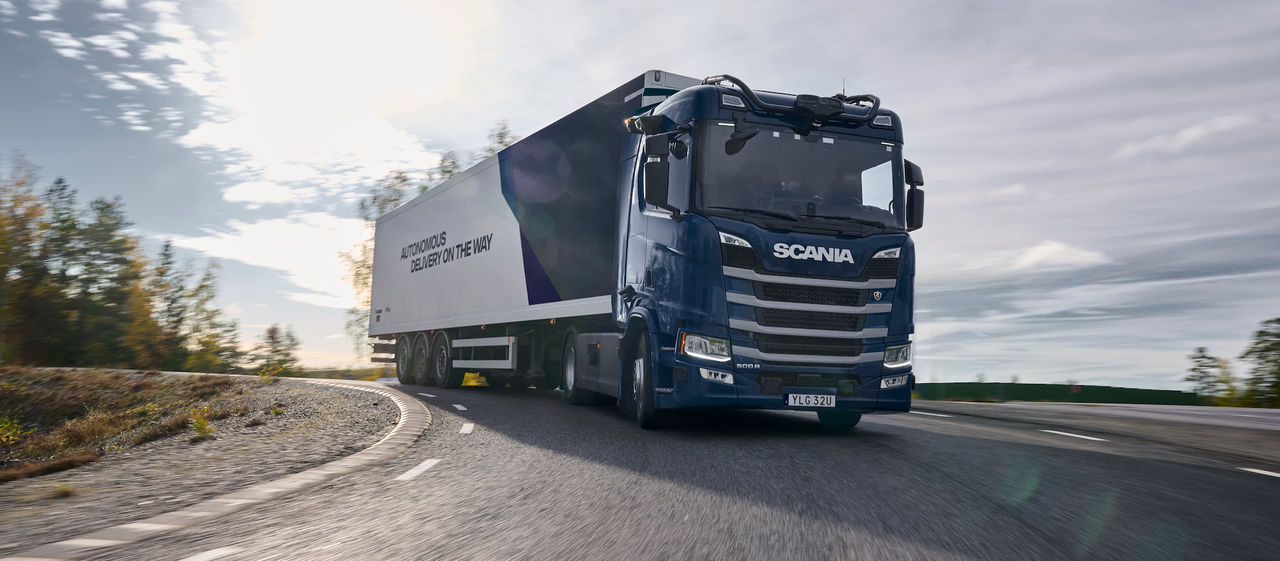
Autonomous hub-to-hub
At Scania, we believe that autonomy is the future of logistics, and we are committed to being at the forefront of this transformation.
The application of autonomous technology for autonomous hub-to-hub transport is steadily gaining pace. With the permission of the Swedish transport authority, Scania is trialling autonomous trucks in open-road conditions in Sweden. The customer advantages are clear, as the use of autonomous hub-to-hub truck solutions can provide significant benefits for logistics companies, resulting in greater efficiency, lower costs, improved safety and tracking, and reduced environmental impact.
Operating 24/7
Scania’s autonomous solutions enables smooth and seamless operations, while our scalable resources support the system with ease.
Logistic companies will greatly benefit from our autonomous hub-to-hub solutions. Our trucks can run 24/7 without rest breaks, optimizing efficiency and reducing delivery times. Cost savings are also significant, for labour, fuel, and maintenance. Improved safety is a major factor, as eliminating human error and driver fatigue greatly reduces the risk of accidents. With the growing shortage of truck drivers, our autonomous trucks address this issue and reduce CO2 emissions by operating in a more fuel-efficient manner.
Maximise uptime
Our autonomous hub-to-hub solution involves using level 4 autonomous trucks to provide non-stop transport between hubs. The entire system is integrated and monitored by operators at a control tower. We have developed software to interface with traditional manual operating systems, allowing us to control the system and receive status updates. This platform enables us to maximise uptime and performance of the vehicles and gives our customers the insights they need to optimise the overall logistics system. The key components of an autonomous system include an autonomous-ready base vehicle, an autonomous driving system which includes a cloud-based control platform, and an operational support network. Scania integrates all these components to create a complete autonomous solution.
Partnerships for game-changing autonomous transport
When it comes to driving technological change for the good of the transport ecosystem, Scania believes in smart partnerships and shared visions. Our close and strong cooperation with Silicon Valley-based software company PlusAI for autonomous road transport pilots is a case in point.
The combination of Scania’s world-class trucks and in-house software capabilities, paired with the cutting-edge AI-based technology provided by PlusAI is set to deliver safe, scalable and factory-built autonomous solutions for the road within a couple of years.
How does autonomous hub-to-hub transport work?
The most important factor for hub-to-hub transport is to integrate as seamlessly as possible into our customers operations and not creating additional complexity in the overall logistics management. Autonomous routes are designed to optimise overall system efficiency and meet the technical requirements of the autonomous system.
- Vehicles are prepared manually with operations such as loading, charging/refuelling and a full safety check. The vehicles are then transported to a launch pad where they are released on an autonomous mission.
- The vehicles drive fully autonomously to their destination hub, while being monitored by the centralised control tower, where they are received, processed, and prepared for the next autonomous mission.
Autonomous Commercial Pilot Programme
The Scania Autonomous Commercial Pilot Programme is part of an increased focus on establishing customer-driven testing to demonstrate hub-to-hub technology, and creating scalable operational concepts that deliver real value in customers’ operations.
Scania´s autonomous trucks on public roads
Fully autonomous vehicles carrying commercial goods on public roads. The pilot, carried out under regular traffic conditions, aimed to learn about the effectiveness of autonomous truck transport as part of hub-to-hub operations.
Discover Scania’s Autonomous Transport Solutions
Thinking about going autonomous?
Do you want more information about our autonomous transport solutions, or have specific questions? Share your contact details and we will contact you to discuss the right solution for your business.